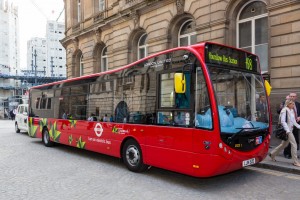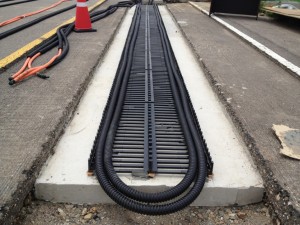Electric Buses in Focus

Source: Transport for London
To be honest, this caught me by surprise: The electric bus movement is as pronounced as the movement to electric vehicles.
In the electric – or eBus – space, there are major advances brewing, matched by cities’ commitments to cut GHGs, fascinating technological advances, and dozens of well-capitalized companies competing for dominance in a huge field of opportunity. I knew this was the case for cars… but I had no idea of the explosion in the e-bus space, nor its innovation.
eBuses come in many varieties, and they seem to be taking over the hybrid electric buses that have combustion engines and motors on board. Are hybrids now a thing of the past?
The most common eBuses are battery-electric buses. The market is moving fast, producing a litany of shuttles, school buses, and city buses for transit systems. There are double-decker electric buses, and articulated and bi-articulated models. Some eBuses are propelled by induction currents embedded in roadways.
There are two major types of eBuses: Autonomous and non-autonomous. The first are autonomous. They are free-range buses with all the range limitations of electric vehicles. Non-autonomous buses are on fixed routes. The most common type are trolley-buses that rely on overhead catenary lines to provide their power. Non-autonomous buses run efficiently without the on-board weight of battery banks, and they run without limitation.
Electric buses suffer the same range anxiety as cars. And while a bus’s heavy chassis can carry more batteries, buses are large, heavy, and thus hard to power. One positive is that electric buses are well suited for city driving with lots of stops and starts. Electric buses have regenerative braking to capture the energy of the bus’s momentum.
Most electric buses have on-board battery banks and are charged at their home base. And the range of the buses is progressing! The Antelope Valley Transit Authority purchased its first 60-foot eBus from BYD which comes with a 547 kWh battery pack that get up to 275 miles on a single charge. (BYD also makes the e6 SVUV with a range of 186 miles, double that of most electric cars on the market. The e6 is showing up in taxi fleets around the world.) Proterra’s eBus gets 200 miles per charge; GreenPower’s electric school buses all get 100 – 125 miles per charge, more than ample for most bus routes.
Then there are a number of promising, emerging charging options: Just as trolley-buses collect their power from overhead catenary lines, “gap buses” grab power from below. Power is supplied over a 4-5″ gap in the road, from a power line embedded in the road.

Cables to be Buried Underground to Power South Korean Tram
One of the most intriguing emerging bus technologies is being promoted by Capabus. It’s a new Chinese bus that uses ultracapacitors – instead of batteries – that are quickly recharged every 3 – 4 miles at bus stops under electric umbrellas.
The best ultracaps hold only 5% of the power of lithium. But what they make up in their inability to store power, is their great ability to charge and recharge quickly. For buses that have to stop frequently anyway, at specific stops, the buses can charge as they go. At bus stops, a collector on the top of the bus rises a few feet to touch an overhead line and to take the charge. This gives them virtually unlimited range plus system efficiency as buses do not need to be taken out of service to charge. The ultracap systems has been tested in Shanghai. Company officials at Sinautec that sponsored the test, claimed that the eBuses bear one tenth of the fuel costs of a diesel bus.
Then there’s the Korean system of online electric vehicles that charge wirelessly while moving by electromagnetic induction, the wireless transfer of power through magnetic fields. It works by embedding a fish bone like structure of wires 30 centimeters under the pavement and “pickup modules” on the vehicle. First launched in 2010 by Korea Advanced Institute of Science and Technology (KAIST), the system controls an electric current that induces buses forward.
